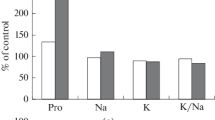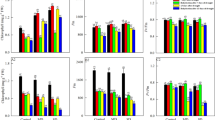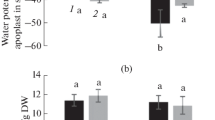Summary
Two subspecies ofHypochaeris radicata were compared with respect to differences in drought tolerance. The soil water content of the sites ofH. radicata ssp. ericetorum Van Soest was always lower than that ofH. radicata L. ssp.radicata throughout a great part of the growing season.
Two water culture experiments were conducted at different light intensities. Water stress was induced by addition of NaCl to the culture solution. Both subspecies accumulated free proline andmyo-inositol during water stress. The results are compared with those of field observations.
In all experiments with stress application ssp.radicata showed heavier wilting symptoms than ssp.ericetorum, concomittantly with a lower osmotic potential of the cell sap, a higher percentage of dry-weight and irreversible desiccation of older leaves in some experiments after stress application. The observed effects are attributed to the higher transpiration rate maintained by ssp.radicata during stress.
Free proline accumulation depended on the severity of the internal stress rather than on the applied level of external stress. At low light intensity the stress resulted in a significantly higher proline accumulation in ssp.ericetorum than in ssp.radicata whereas at high light intensity this was the reverse. No differences inmyo-inositol accumulation were observed in the water culture experiments. Since ssp.ericetorum occurs in a nitrogen poor environment, the effect of nitrogen deprivation on accumulation of free proline andmyo-inositol was investigated. Both subspecies tended to accumulate less proline under such conditions especially ssp.radicata. Accumulation ofmyo-inositol was not favoured by nitrogen deprivation in the water culture experiments.
Neither of the subspecies accumulated proline during the sampling period in the field presumably as a result of the wet summer. Leaves of whole plants collected in the field and subsequently subjected to water deprivation showed a high capacity to accumulate free proline. The level ofmyo-inositol in the field was higher in ssp.ericetorum than in either ssp.radicata or control plants in the water culture experiments. When the cytoplasmic volume is estimated as 10% of the total cell volume, free proline andmyo-inositol account for 44–69% of the osmotic potential.
It is concluded that ssp.ericetorum is better adapted to the drier environment by its higher capacity to accumulate proline and reduce transpiration during stress.
Similar content being viewed by others
References
Ahmad, I., Larher, F. and Stewart, G. R. 1979 Sorbitol, a compatible osmotic solute inPlantago maritima New Phytol.82, 671–678.
Bates, L. S., Waldren, R. P. and Teare, L. D. 1973 Rapid determination of free proline for water-stress studies Plant and Soil39, 205–207.
Eisenberg, F. Jr. 1971 Cyclic butaneboronic acid esters: Novel derivates for the rapid separation of carbohydrates by gas-liquid chromatography. Carbohydr. Res.19, 135–138.
Ferreira, L. G. R., De Souza, J. G. and Prisco, J. T. 1979 Effects of water deficit on proline accumulation and growth of two cotton genotypes of different drought resistances. Z. Pflanzenphysiol.93, 189–199.
Flowers, T. J., Troke, P. F. and Yeo, A. R. 1977 The mechanism of salt tolerance in halophytes. Annu. Rev. Plant Physiol.28, 89–121.
Gorham, J., Hughes, L. L. and Wyn Jones, R. G. 1980 Chemical composition of salt-marsh plants from Ynys Môn (Anglesey): the concept of physiotypes. Plant Cell Environ.3, 309–318.
Göring, H. and Thien, B. H. 1979 Influence of nutrient deficiency on proline accumulation in the cytoplasm ofZea mays L. seedlings. Biochem. Physiol. Pflanzen174, 9–16.
Hanson, A. D., Nelson, C. E. and Everson, E. H. 1977 Evaluation of free proline accumulation as an index of drought resistance using two contrasting barley cultivars. Crop Sci.17, 720–726.
Hellebust, J. A. 1976 Osmoregulation. Annu. Rev. Plant Physiol.27, 485–505.
Heukels, H. and Van Ooststroom S. J. 1968 Flora van Nederland. Wolters-Noordhoff B.V., Groningen, 15th edition.
Hoagland, D. R. and Snijder, W. C. 1933 Nutrition of strawberry plant under controlled conditions. Proc. Am. Soc. Hortic. Sci.30, 288–296.
Hubac, C. and Guerrier, D. 1972 Étude de la composition en acides aminés de deuxCarex: leCarex stenophylla wahl. f. Pachystylis (J. Gay) Asch. et Graeb., très résistant à la sécheresse et leCarex setifolia Godron non Kunze, peu résistant. Effet d'un apport de proline exogène. Ecol. Plant7, 147.
Humphries, E. C. 1956 Mineral components and ash analysis.In Modern Methods of Plant Analysis. Eds. Peach and Tracey, Vol.1, pp 481–483.
Lewis, J. C. and Powers, W. L. 1941 Antagonistic action of chlorides on the toxicity of iodides to corn. Plant Physiol.16, 393–398.
Lewis, D. H. and Smith, D. C. 1967 Sugar alcohols (polyols) in fungi and green plants. I. Distribution, physiology and metabolism. New Phytol.66, 143–184.
Mizrahi, Y., Blumenfeld, A. and Richmond, A. E. 1970 Abscissic acid and transpiration in leaves in relation to osmotic root stress. Plant Physiol.46, 169–171.
Schobert, B. and Tschesche, H. 1978 Unusual solution properties of proline and its interaction with proteins. Biochim. Biophys. Acta541, 270–277.
Singh, T. N., Paleg, L. G. and Aspinall, D. 1973 Stress metabolism III. Variations in response to water deficit in the barley plant. Aust. J. Biol. Sci.26, 65–76.
Storey, R. and Wyn, Jones, R. G. 1977 Quaterny ammonium compounds in plants in relation to salt resistance. Phytochemistry16, 447–453.
Van de Dijk, S. J. 1980 Two ecologically distinct subspecies ofHypochaeris radicata L. I. Nitrate uptake and nitrate utilization. Plant and Soil56, 465–473.
Van de Dijk, S. J. 1980 Two ecologically distinct subspecies ofHypchaeris radicata L. II. Growth response to nitrate and ammonium, growth strategy and formative aspects. Plant and Soil57, 111–122.
Van de Dijk, S. J. and Troelstra, S. R. 1980 Heterotrophic nitrification in a heath soil demonstrated by anin situ method. Plant and Soil57, 11–21.
Van de Dijk, S. J. 1981 Differences in nitrate uptake of species from habitats rich or poor in nitrogen when grown at low nitrate concentrations, using a new growth technique. Plant and Soil62, 265–278.
Author information
Authors and Affiliations
Additional information
Grassland species research group, publication no41.
Rights and permissions
About this article
Cite this article
Van De Dijk, S.J. Two ecologically distinct subspecies ofHypochaeris radicata L.. Plant Soil 63, 149–163 (1981). https://doi.org/10.1007/BF02374594
Received:
Revised:
Issue Date:
DOI: https://doi.org/10.1007/BF02374594




